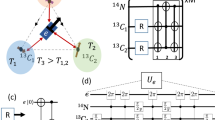Abstract
Heat-bath algorithmic cooling (HBAC) has been proven to be a powerful and effective method for obtaining high polarization of the target system. Its cooling upper bound has been recently found using a specific algorithm, the partner pairing algorithm (PPA-HBAC). It has been shown that by including cross-relaxation, it is possible to surpass the cooling bounds. Herein, by combining cross-relaxation and decoherence-free subspace, we present a two-qubit reset sequence and then generate a new algorithmic cooling (AC) technique using irreversible polarization compression to further surpass the bound. The proposed two-qubit reset sequence can prepare one of the two qubits to four times the polarization of a single-qubit reset operation in PPA-HBAC for low polarization. When the qubit number is large, the cooling limit of the proposed AC is approximately five times as high as the PPA-HBAC. The results reveal that cross-relaxation and decoherence-free subspace are promising resources to create new AC for higher polarization.
Similar content being viewed by others
Change history
19 May 2020
In this work, HengYan Wang and Jian Pan contributed equally to this work. The annotation for the contribution was omitted in the original publication of this paper [1]. It can be conformed in the submitted PDF version of the manuscript. Hence, the sentence ���HengYan Wang and Jian Pan contributed equally to this work.��� should be added.
References
J. H. Ardenkjaer-Larsen, B. Fridlund, A. Gram, G. Hansson, L. Hansson, M. H. Lerche, R. Servin, M. Thaning, and K. Golman, Proc. Natl. Acad. Sci. USA 100, 10158 (2003).
D. A. Hall, D. C. Maus, G. J. Gerfen, S. J. Inati, L. R. Becerra, F. W. Dahlquist, and R. G. Griffin, Science 276, 930 (1997).
W. S. Warren, N. Gershenfeld, and I. Chuang, Science 277, 1688 (1997).
T. D. Ladd, F. Jelezko, R. Laflamme, Y. Nakamura, C. Monroe, and J. L. O’Brien, Nature 464, 45 (2010), arXiv: 1009.2267.
Z. H. Luo, J. Li, Z. K. Li, L. Y. Hung, Y. D. Wan, X. H. Peng, and J. F. Du, Sci. China-Phys. Mech. Astron. 62, 980311 (2019).
K. Zhang, J. Li, M. Jiang, N. Zhao, and X. H. Peng, Sci. China-Phys. Mech. Astron. 61, 080314 (2018).
B. Criger, O. Moussa, and R. Laflamme, Phys. Rev. A 85, 044302 (2012), arXiv: 1201.1517.
P. O. Boykin, T. Mor, V. Roychowdhury, F. Vatan, and R. Vrijen, Proc. Natl. Acad. Sci. 99, 3388 (2002), arXiv: quant-ph/0106093.
J. M. Fernandez, S. Lloyd, T. Mor, and V. Roychowdhury, Int. J. Quantum Inform. 02, 461 (2004).
L. J. Schulman, T. Mor, and Y. Weinstein, Phys. Rev. Lett. 94, 120501 (2005).
Y. Elias, J. M. Fernandez, T. Mor, and Y. Weinstein, Isr. J. Chem. 46, 371 (2006).
Y. Elias, T. Mor, and Y. Weinstein, Phys. Rev. A 83, 042340 (2011), arXiv: 1110.5892.
Y. Atia, Y. Elias, T. Mor, and Y. Weinstein, Phys. Rev. A 93, 012325 (2016).
J. Baugh, O. Moussa, C. A. Ryan, A. Nayak, and R. Laflamme, Nature 438, 470 (2005), arXiv: quant-ph/0512024.
C. A. Ryan, O. Moussa, J. Baugh, and R. Laflamme, Phys. Rev. Lett. 100, 140501 (2008), arXiv: 0706.2853.
D. K. Park, N. A. Rodríguez-Briones, G. R. Fent, R. Rahimi, J. Baugh and R. Laflamme, in Heat Bath Algorithmic Cooling with Spins: Review and Prospects: Electron Spin Resonance (ESR) Based Quantum Computing, edited by T. Takui, L. Berliner, and G. Hanson (Springer, New York, 2016), p. 227.
S. Raeisi, and M. Mosca, Phys. Rev. Lett. 114, 100404 (2015), arXiv: 1407.3232.
N. A. Rodríguez-Briones, and R. Laflamme, Phys. Rev. Lett. 116, 170501 (2016).
B. N. Provotorov, Sov. Phys. JETP 15, 611 (1962).
J. Li, D. Lu, Z. Luo, R. Laflamme, X. Peng, and J. Du, Phys. Rev. A 94, 012312 (2016).
A. W. Overhauser, Phys. Rev. 89, 689 (1953).
N. A. Rodríguez-Briones, J. Li, X. Peng, T. Mor, Y. Weinstein, and R. Laflamme, New J. Phys. 19, 113047 (2017), arXiv: 1703.02999.
D. A. Lidar, in Review of Decoherence-Free Subspaces, Noiseless Subsystems, and Dynamical Decoupling: Quantum Information and Computation for Chemistry, edited by S. Kais (John Wiley & Sons, Hobo-ken, 2014), pp. 295–354.
N. Khaneja, T. Reiss, B. Luy, and S. J. Glaser, J. Magn. Reson. 162, 311 (2003).
E. Knill, R. Laflamme, R. Martinez, and C. H. Tseng, Nature 404, 368 (2000).
D. A. Yablonskiy, and E. M. Haacke, Magn. Reson. Med. 32, 749 (1994).
Author information
Authors and Affiliations
Corresponding authors
Rights and permissions
About this article
Cite this article
Wang, H., Pan, J., Zheng, W. et al. Algorithmic cooling based on cross-relaxation and decoherence-free subspace. Sci. China Phys. Mech. Astron. 63, 270311 (2020). https://doi.org/10.1007/s11433-019-1492-4
Received:
Accepted:
Published:
DOI: https://doi.org/10.1007/s11433-019-1492-4




